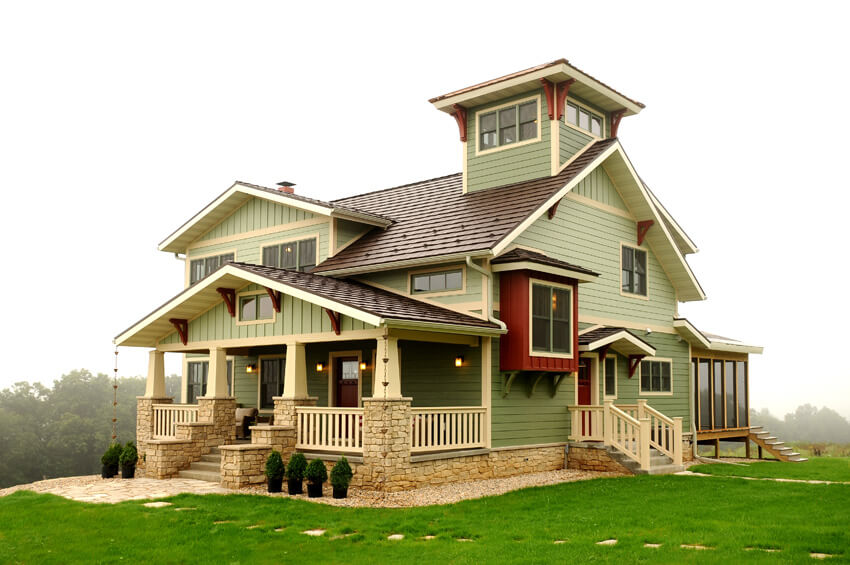The Arts and Crafts movement, originating in the late 19th century, encompassed a range of artistic and architectural styles that celebrated craftsmanship, simplicity, and the integration of nature. One of the most enduring and iconic expressions of this movement is the Arts and Crafts bungalow. In this blog article, we will take a closer look at this architectural style. Divided into three parts, each containing two levels of content, we will explore the history, key features, and design elements that make Arts and Crafts bungalows truly distinctive.

Part 1: The Origins and Characteristics of Arts and Crafts Bungalows
Level 1: Historical Context and Influences
- The Arts and Crafts Movement: The Arts and Crafts movement emerged in response to the rapid industrialization of the Victorian era. It emphasized the value of handcrafted goods, the importance of skilled artisans, and a return to the simplicity and honesty of nature in design.
- Influence of Asian Architecture: The Arts and Crafts movement drew inspiration from the simplicity and natural materials found in Japanese and Indian architecture. The clean lines, open floor plans, and integration of indoor and outdoor spaces found in these styles heavily influenced the design of Arts and Crafts bungalows.
Level 2: Key Features and Design Elements
- Low-Pitched Roof: One of the defining characteristics of an Arts and Crafts bungalow is its low-pitched roof. Often featuring wide eaves, exposed rafters, and decorative brackets, this roof style provides a sense of shelter and coziness while also contributing to the overall aesthetic appeal.
- Emphasis on Natural Materials: Arts and Crafts bungalows showcase a preference for natural materials such as stone, brick, wood, and stucco. These materials are often left exposed or used in their natural state to highlight their inherent beauty and texture.
Part 2: The Interior Design of Arts and Crafts Bungalows
Level 1: Functional Design Principles
- Open Floor Plans: Arts and Crafts bungalows typically feature open floor plans that allow for a seamless flow between rooms. This design approach creates a sense of spaciousness and facilitates social interaction, reflecting the movement’s rejection of compartmentalized Victorian spaces.
- Built-In Features: A hallmark of Arts and Crafts design is the use of built-in features, such as bookshelves, benches, and cabinetry. These elements not only maximize space but also enhance the craftsmanship and overall unity of the interior.
Level 2: Arts and Crafts Aesthetics
- Exposed Woodwork: Arts and Crafts bungalows often showcase exposed woodwork, including beams, paneling, and trim. These elements are typically left unpainted or stained to emphasize the natural beauty of the wood.
- Handcrafted Details: The Arts and Crafts movement emphasized the value of skilled craftsmanship, and this is reflected in the intricate details found within Arts and Crafts bungalows. From hand-carved motifs and decorative tiles to stained glass windows and leaded glass lamps, these details add an element of artistry and individuality to the interior spaces.
Part 3: The Evolution and Legacy of Arts and Crafts Bungalows
Level 1: Contemporary Adaptations
- Revival of the Style: While the original Arts and Crafts bungalows were prevalent from the late 19th to the early 20th century, there has been a revival of interest in recent years. Contemporary architects have embraced the values of the Arts and Crafts movement, creating modern interpretations of the bungalow style that incorporate sustainable materials and energy-efficient design principles.
- Preservation and Restoration: Many original Arts and Crafts bungalows have been lovingly preserved and restored. Homeowners and architectural enthusiasts recognize the historical and cultural significance of these houses, ensuring that future generations can appreciate their unique charm and architectural integrity.
Level 2: Influence on Subsequent Architectural Trends
- Craftsman Style: The Arts and Crafts bungalow heavily influenced the development of the Craftsman style, which emerged around the same time. Craftsman homes share many characteristics with Arts and Crafts bungalows, including low-pitched roofs, exposed rafters, and a focus on handcrafted details.
- Impact on Modern Architecture: The principles of simplicity, functionality, and integration with nature that underpin Arts and Crafts bungalows have had a lasting impact on modern architectural styles. Contemporary architects continue to draw inspiration from this movement, incorporating its ethos into innovative designs that prioritize sustainable living and harmonious relationships with the environment.
Conclusion:
The Arts and Crafts bungalow stands as a testament to the enduring legacy of the Arts and Crafts movement. From its origins in the late 19th century to its contemporary adaptations, this architectural style continues to captivate homeowners and architects alike. Whether it’s the low-pitched roofs, emphasis on natural materials, open floor plans, or handcrafted details, the Arts and Crafts bungalow epitomizes the values of craftsmanship, simplicity, and connection with nature. By preserving and celebrating these unique homes, we honor the rich history and artistic spirit of the Arts and Crafts movement.